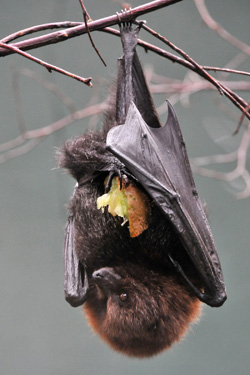September 23, 2013 - By Rob Jordan
It usually starts with a fever and headache, maybe some coughing and a disoriented feeling. Before long, inflammation of the veins, arteries and brain sets in, a seizure takes hold and you lose consciousness. Seven out of 10 cases end in death. Of those who survive, one-third have permanent, crippling neurological disorders.

Fruit bats can carry the Nipah virus but are immune to it.
That's the fate of people unlucky enough to be infected with the Nipah virus in Bangladesh, where outbreaks occur in most years. But people outside Southeast Asia have reason to be concerned too, according to Stephen Luby, MD, professor of medicine and director of research at Stanford's Center for Innovation in Global Health. If the virus adapts to more efficient human-to-human transmission, "then in our globally connected world, humanity could face its most devastating pandemic," Luby writes in a commentary published in the journal Antiviral Research.
To avoid this outcome, Luby, a senior fellow at the Stanford Woods Institute for the Environment and the Freeman Spogli Institute for International Studies, suggests a range of measures.
Discovered in 1999, Nipah can be traced to Pteropus bats, commonly known as fruit bats, which carry the virus but are immune to it. In Bangladesh, these bats transmit the virus to humans through raw date palm sap, which the bats are known to lick and urinate in as it is harvested for human consumption. Children love the treat with puffed rice in the morning.
Sustained person-to-person transmission of Nipah through contact with bodily secretions has been limited so far. Still, there is significant cause for concern that Nipah could spread faster and wider. Fruit bats can be found over a range stretching from Pakistan across South and Southeast Asia, up the coast of Southern China and down into Australia. Climate change and other environmental factors could expand the bats' range.
Among Nipah's worrisome traits: Many strains are capable of limited person-to-person transmission, and it is a ribonucleic-acid virus, which has the highest known rate of mutation among biological agents. If a more efficient human-adapted strain developed, it could spread rapidly in highly populous South Asia before spilling into other regions.
The global community must do a better job of estimating and managing the risk, Luby said. That will require stepped-up study of how the virus is transmitted, closer observation of infected people and consideration of vaccinations for at-risk communities.
Rich countries need to help improve poor countries' health-care systems — specifically, making sure health-care workers have access to protection such as gloves and hand washing — to help prevent spread, Luby said. In densely populated Bangladesh, health-care providers who treat Nipah patients typically lack gloves and masks, while patient attendants often lack soap and water for hand washing.
Beyond stopping the spread of Nipah, such measures would reduce the risk of influenza and other disease pandemics, according to Luby. "I think it important that taxpayers in the U.S. recognize that investments in prevention in low-income, high-risk countries can protect their own lives."
About Stanford Medicine
Stanford Medicine is an integrated academic health system comprising the Stanford School of Medicine and adult and pediatric health care delivery systems. Together, they harness the full potential of biomedicine through collaborative research, education and clinical care for patients. For more information, please visit med.stanford.edu.